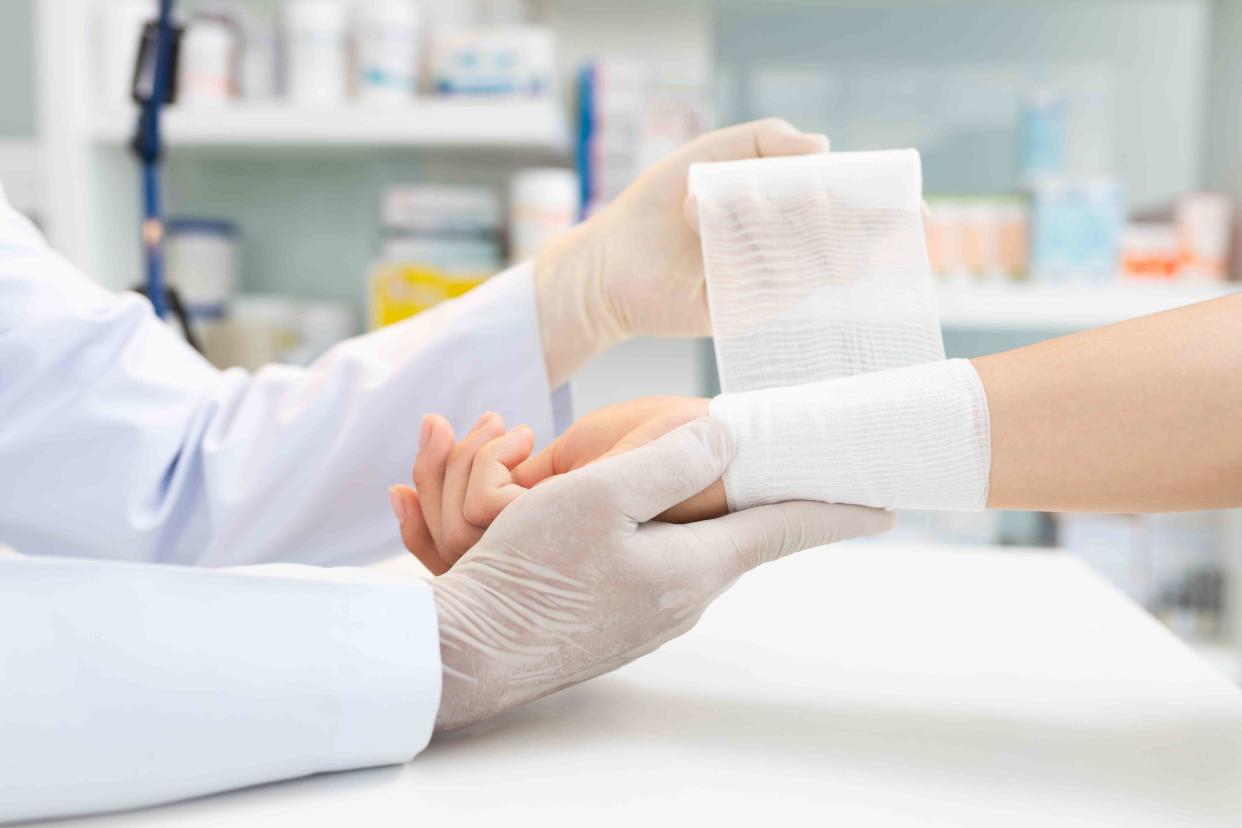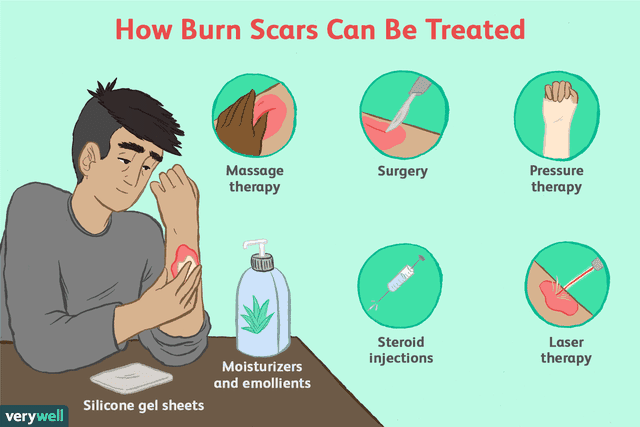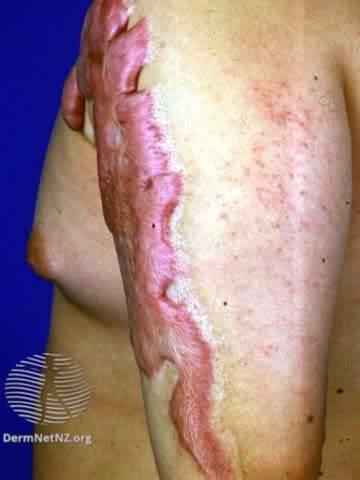Do Burn Scars Go Away?

Medically reviewed by Casey Gallagher, MD
Burn marks may not go away completely, but they will fade over time. Treatments like topical creams and laser therapy can also help reduce the appearance of a burn scar. The severity of scarring and how much its appearance can be reduced depends on the depth of the burn and how it was initially treated and managed.
This article goes over some of the treatments that can help reduce the appearance of burn marks and scars.

Verywell / Brianna Gilmartin
What Is a Burn Mark?
A burn mark is an area of skin that has been damaged by heat. Superficial burns that affect only the outer layers of skin typically leave less obvious scars that fade over time. Burns that reach deeper layers of skin tend to leave scars that are thicker and have a much more prominent appearance.
People with fair skin tend to develop scars that are pink or red in color, while people with darker skin often develop darker colored scars. People with dark skin are more likely to develop pale scars due to loss of pigment or thick scars called keloids.
Types of Burn Scars
The type of scar that develops after a burn often depends on the severity of the burn. Burns are classified as either first, second, or third-degree.
First-degree burns are superficial, which means they only affect the outer layer of skin, called the epidermis. First-degree burns are red and painful but they don't blister.
Second-degree burns reach the second layer of skin, called the dermis. These burns are bright red, painful, and develop blisters. There may also be significant swelling.
Third-degree burns go all the way through the epidermis and dermis. They may even damage muscles, tendons, and bones. Their appearance is black and charred or white. If you have a third-degree burn you won't have any sensation in the severely burned tissue where the nerve endings have been destroyed.
Burn scars heal differently depending on how severe they are, how they are treated, and how your body's healing process progresses.
Hypertrophic scars: These are raised, textured scars. They are common in people with severe burns, especially if the burn became infected or the person has a weakened immune system or a chronic inflammatory condition.
Atrophic scars: A burn can also leave a depression in the skin, known as an atrophic scar.
Keloids: This type of scar is thick and raised and may extend beyond the original injury site.
Scars can also be categorized according to their color.
Hyperpigmented scars are darker than the surrounding skin. Hyperpigmentation occurs when there is an overproduction of melanin, the substance that gives your skin its color.
Hypopigmented scars are caused by an underproduction of melanin. These scars may look pale or white.
You may also hear healthcare providers talk about contracture scars. This term describes any type of scar that limits movement. A contracture scar forms when healed tissues are tighter and thicker than normal skin. For example, a contracture scar on the arm can make wrist, forearm, and finger movement more difficult.
Many second and third-degree burns can cause contracture scars, and this is one of the reasons why proper burn treatment is important.
First-degree burns can leave a scar, especially without proper treatment. To treat a first-degree burn and prevent scarring, remember these steps:
Cool the burn using cool (not cold) water for around 10 minutes or until pain goes away.
Apply petroleum jelly to the burn two or three times each day.
Keep the burn area covered with a clean, non-stick bandage.
If needed, take an over-the-counter pain medication for pain relief and to reduce inflammation.
Keep the burn away from direct sunlight. Stay in the shade, wear protective clothing, and apply water-resistant sunscreen that is SPF 30 or higher.
Burn Scar Treatment
Treatments for burn scars generally fall under four main categories:
Non-surgical specialist procedures
Laser therapy
Surgery
Treatment options depend on whether you want to improve the appearance or whether the scar has caused skin contractures (tight areas of skin) that affect your ability to move.
Over-The-Counter Treatment
Over-the-counter (OTC) treatments can help reduce symptoms associated with burns and the scars that develop. They may also help reduce the appearance of scars.
Moisturizers and emollients: Burns impair or destroy oil glands in the affected area, which leads to dry and itchy skin. Using moisturizers and emollients can help. Choose unscented/fragrance-free creams to avoid skin irritation. Apply moisturizers carefully and gently when the burn scars are still new. With time, as the scars become less fragile, you can apply more pressure when applying moisturizer to help prevent scar stiffness and loosen up the area.
Silicone Gel Sheets: These are thin pieces of medical-grade silicone that are worn on the skin to help with scarring. They have been used in the treatment of burn scars for more than 30 years and are accepted as one of the best non-surgical options for burn scars. Silicone gel reduces the thickness of burn scars and diminishes itchiness and pain at the site of the scar. Silicone gel sheets can be used even if your scars are causing stiffness and interfering with movement. For maximum effectiveness, you should use silicone gel sheets on your skin for at least six to 12 months of constant wear.
When using silicone gel sheets, it's important to you keep your skin clean to avoid rashes, irritation, or infections, especially if you live in a hot or warm weather area. You shouldn't use silicone over any unhealed skin or in combination with antibiotic skin ointments.
Allergic reactions to silicone gel are rare. If you start to develop any skin reaction, you should stop applying it immediately and go see your healthcare provider.
Massage Therapy
Massage therapy is used to reduce the pain, skin sensitivity, and itchiness that usually come with burn scars. Additionally, it can reduce the height and appearance of your burn scars. And because it involves manipulating the scar tissue that’s under your skin, massage therapy lessens the tightness and restriction of movement. If you’re having trouble moving the affected areas freely and fluidly, properly administered massage therapy can help.
There are different kinds of massage techniques used in burn centers, including kneading, skin rolling, stretching, and stroking. Your healthcare provider or occupational therapist should instruct you on how and when to perform these techniques at home.
You shouldn’t massage skin that’s infected, fragile, or not fully healed.
A few home remedies are said to help reduce the appearance of burn scars, such as:
Aloe vera. Use gel from the aloe vera leaf or purchase an aloe vera product that is free from dyes and perfumes.
Honey. Honey has antibacterial and anti-inflammatory properties that can help a burn heal and may also help reduce scarring.
Pressure Therapy
This method of treating burn scars has been in use for decades and it is usually the first treatment option for hypertrophic (raised scars) in burn centers.
The treatment uses pressure garments—elastic garments that are worn to apply pressure to the scar areas. If the burn scars are on your face, the pressure will be applied using transparent face masks. Pressure therapy should be used for 6 to 12 months in order for it to be effective, and it is advised that you wear the garments for 23 hours per day.

DermNet / CC BY-NC-ND
Hypertrophic burn scarWhile it’s a very effective method of treating (and even preventing) hypertrophic burn scars, there are a couple of problems associated with pressure therapy:
Wearing pressure garments can be very uncomfortable and can cause blistering, particularly if you live in a hot and humid climate.
The garments can cause overheating, itchiness, and wound breakdown.
Pressure therapy is to be implemented by your healthcare provider while you’re at the hospital, and you’ll continue with it at home as directed.
It’s important to note that despite its pervasiveness in hospitals and clinics, there isn't a lot of medical literature backing up the efficacy of pressure therapy.
Steroid Injections
Steroid injections are mainly used to treat keloid scars (raised, smooth, thick, and rounded scars that sometimes go outside the boundaries of the original burn injury). Steroids, such as corticosteroids, are injected into the scars to soften and shrink them. The injected steroids can also help reduce the pain and itching that’s generally associated with burn scars.
If you receive this line of treatment, you may experience side effects, such as skin discoloration and skin thinning. Allergic reactions to steroid injections are very uncommon.
Steroid injections are done at the hospital or clinic and you shouldn't try to do them yourself at home.
Related:The Pros and Cons of Cortisone Injections
Laser Therapy
Laser treatments are used to relieve tightness, discomfort, and pain from burn scars, as well as smooth them out and diminish their redness. There are different kinds of laser therapies used to treat burn scars. The main ones are pulse-dyed laser, fractional laser (ablative and non-ablative), CO2 laser, and Q-switched laser. If you’re considering whether or not to have laser treatments, consult with your healthcare provider.
Before and after having laser therapy, you should be diligent about sun protection. Following your surgeon’s or dermatologist’s post-laser instructions in taking care of the site is also a must.
With laser treatment, it’s possible that you may need more than one treatment and it may also take several weeks before you start to see results.
Common side effects of laser treatments include redness, swelling, hyperpigmentation (dark skin discoloration), itching, and the formation of new scars. The consensus drawn from many studies and clinical trials is that using laser therapy to treat burn scars is safe enough that the benefits outweigh the potential risks.
Surgery
Surgery can be an option for treating scarring when large areas of skin have been severely damaged, causing contractures to form, with tight skin and limited movement.
Most surgeries performed on burn scars are done to improve range of motion, and this may sometimes necessitate the removal of scar tissue that has formed underneath the skin. The types of surgeries used to treat burn scars include the following:
Skin flap: This procedure is very similar to a skin graft, with the major difference being that the skin taken from the healthy body part has its own blood supply. This means blood vessels, fat, and muscles are taken along with the piece of skin. This procedure is usually used when the blood supply to the scarred skin is damaged.
Z plasty: This surgical procedure involves making a Z-shaped incision into your burn scars. It reduces the number of contractures, thereby improving flexibility and decreasing tightness. It also minimizes the appearance of the scars and can be used to reposition your scars in order to make them less noticeable and blend in better with natural creases in the surrounding skin areas.
Tissue expansion: This procedure is often used in addition to flap surgery when the burn scars are to be removed either partially or in their entirety. A balloon-like object is placed under an uninvolved part of your skin near the scarred area. This tissue expander is continuously filled with saline solution causing the skin to stretch out over time. When there's enough new skin, the scar is removed and the stretched skin is pulled over to cover the opening.
Dermabrasion: Dermabrasion involves surgically sanding and scraping the top layer of your burn scars in order to make them smoother and improve their appearance.
Fat graft: This surgical procedure can be used if your burn scars are uneven and depressed in some places. It involves transplanting fat from a healthy part of your body to the scarred and depressed areas to raise them and make their appearance smoother.
Skin graft: During this procedure, a thin piece of skin is taken from an unaffected part of the body (usually the buttocks or inner thigh) and used to replace the scarred skin. After the surgery, your skin should be more flexible, but you may have scarring with skin texture irregularities or discoloration.
Your healthcare provider may have you wait months or even years before a burn scar surgery so your body to heal fully and properly. This depends on the size and location of your burn, and how well it is healing.
Related:What to Expect During a Skin Graft
Burn Scar Treatment Complications
The different treatments and surgeries come with their own unique risks and side effects, all of which you should discuss with your surgeon or healthcare provider prior to undergoing them. Some potential complications include:
A reaction to surgical anesthesia
Bleeding and/or infection
Pigment changes
The appearance of the scar may worsen in some people, especially those who scar easily
Burn Scar Treatment Recovery
While results and effects vary, there are a couple of things you should expect after undergoing surgery for your burn scars:
You should expect your healthcare provider or surgeon to give you detailed instructions for taking care of the site when you get home. To avoid post-surgery complications, it’s crucial that you adhere to these instructions.
You should know that some of these surgical procedures can involve pain, especially in the aftermath after the anesthetic you may have been given has worn off. Swelling and redness around the scar area are also common.
When To See a Healthcare Provider
If you develop a large, raised scar or a keloid, talk to your healthcare provider about treatment options to help reduce the appearance of your scar. You should also see your healthcare provider if you develop a scar that interferes with your normal range of motion.
Summary
Burn scars don't usually disappear, but they do fade over time. Treatment can also help reduce the appearance of a burn scar, though the treatment you receive will depend on the type of scar you have, the severity of the burn that caused it, and whether or not the scar interferes with your normal range of motion.
Treatment options for burn scars include over-the-counter creams and ointments, non-surgical treatments like massage and pressure therapy, laser therapy, and surgery. These treatments aren't perfect and can lead to complications.
A Word From Verywell
With burn scar treatments it’s imperative that you discuss your options with your healthcare provider or surgeon before undergoing any of them. Some of these treatments can be used in combination with each other, or in sequence.
It’s also important for you to have realistic expectations, as it is highly unlikely that your burn scars will go away completely (except when they are really minor). Surviving serious burns and being left with scars can be devastating and can affect your confidence. If you are struggling to accept the changes in your appearance, consider visiting a psychologist or therapist who can help you with emotional and psychological healing.

